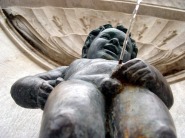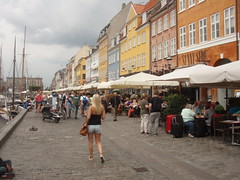Brussels
Brussels began as a group of little islands on a marshy river. legend has it that in the 6th century AD, St. Gery, Bishop of Cambrai, founded a church on one of these islands, and a settlement grew around it. The name Bruocsella (later Brussels), meaning ”house of the swamp”, is first mentioned in 966, and a castle was builton the island by Charles, Duke of Lorraine, a decade later, effectively launching the city.
 The center of Brussels is neatly contained within a clearly defined shape called the Pentagon. Nowadays this outline is formed by a busy ring road called the Petite Ceinture. The road follows the path of the old city walls, a huge 14th century construction 9 km long. Few traces of the walls have survived, but one old city gate, the Porte de Hal, still stands, and gives a fair indication of just how massive the fortifications must have been. Most of historic Brussels is contained within these bounds, including both the commercial and popular districts of the Lower Town, and the aristocratic quarter of the Upper Town, which includes the Royal Palace. The result is that Brussels is still a very compact city. You can walk right across the Pentagon in about half an hour. As well as monuments and cultural gems, you will find a concentration of excellent places to stay and eat, good shops, and vibrant caffes and bars.
The center of Brussels is neatly contained within a clearly defined shape called the Pentagon. Nowadays this outline is formed by a busy ring road called the Petite Ceinture. The road follows the path of the old city walls, a huge 14th century construction 9 km long. Few traces of the walls have survived, but one old city gate, the Porte de Hal, still stands, and gives a fair indication of just how massive the fortifications must have been. Most of historic Brussels is contained within these bounds, including both the commercial and popular districts of the Lower Town, and the aristocratic quarter of the Upper Town, which includes the Royal Palace. The result is that Brussels is still a very compact city. You can walk right across the Pentagon in about half an hour. As well as monuments and cultural gems, you will find a concentration of excellent places to stay and eat, good shops, and vibrant caffes and bars.

Grand Place – A remarkable legacy of the city’s Gothic and renaissance past, it is also a monument to the values and ingenuity of the artisans and merchants who were the architects of Brusses prosperity
Grand Place Top Hotels in Brussels
No trip to Brusseles would be complete without a visit to the Grand Place- even if it’s just to stock up on some Belgian biscuits or chocolates. Brussel’s Grand Place is the focal point of the city, a tirelessly uplifting masterpiece of unified architecture. Flanked by tightly packed rows of former guild houses, bristling with symbolic sculpture and gilding, for many centuries this was the proud economic and administrative heart of the city. It was the setting for markets and fairs, pageants and jousts, for the proclamation of decrees and public executions. Even without its old political and economic prestige and the bustle of through traffic, it still throbs with animation.
10 Brussels Must Sees
- Be awed by the sheer theatricality of the Grand Place;
- Delve into unexplored areas of your mind with the Symbolists at the Musees Royaux des Beaux Arts;
- Shop in the vaulted, marble halls of the Galeries Royales de Saint Hubert;
- Submit to the the majestic enormity of the Palais de Justice;
- View the Baroque splendour of the pulpit of the Cathedrale des Saints;
- See the inventive Manneken Pis Costumes in the Maison du Roi;
- Savour the medieval gloom of the Eglise Notre Dame au Sablon;
- Admire Art Noveau in its perfect expression at Musee Horta
- Witness the larger than life display of the tiny at the Atomium;
- See where the sublime and the ridiculous blend in harmony at the Musee Antoine Wiertz
The Pentagon
The first city walls to enclose Brussels were built in about 1100 but the city expanded and they were superseded in 1379, creating the neat pentagon shape that is evident today. These walls were eventually knocked down in the mid 19th century to make way for treelined boulevards. Of the city gates, only the Porte de Hal remains.

No one knows why this tiny bronze statue of a boy peeing a jet of water has become such a cherished symbol of Brussels, but it has.
Manneken – Pis
In Brussels you can’t avoid this cheeky little chap, famously pissing with carefree abandon just as little boys do. Among other things, he’s on postcards, T-shirts, key rings and corkscrews. So why not take a pilgrimage to see the real thing – a tiny bronze statue, and bask in the happy absurdity of it all?

Atomium – this giant model of metal molecule was built as Belgium’s exhibit at Brussels 1958 Universal Exposition
Outer Brussels
Over the centuries, Brussels expanded beyond the old city walls, gradually absorbing neighboring towns and villages. These outlying communes such as Ixelles, Saint-Gilles and Anderlech still retain their distinctive characters. As a result, there is huge variety across Outer Brussels.An excellent public transport system makes it easy to scoot around these suburbs, and the highlights listed here are definitely worth the journey.
A Walk through the Brussels of Leopold II – Put on your best walking shoes, because you’re going to cover at least 5km of pavememtn and take in half a dozen museums. You don’t have to do them all, of course, and don’t try this on a Monday, when most of the museums are closed. Start at the Schuman metro station in the heart of the European Quarter, close to the Justus Lipsius Building. If you’re feeling energetic, stride up Rue Archimede to admire the weirdest Art Noveau building of them all – the Hotel Saint Cyr in Square Ambiorix. To refresh yourself, go to Place Jourdan, where ther are cafes and restaurants to suit all pockets. Cross the Park Leopold to visit the wacky Musee wiertz, than walk about 1 km to the delightful Musee Communal d’Ixelles. If you had enough already, you could slink into the trendy Cafe Belga in the 1930’s Flagey radio building, otherwise push on down the Chausseede Vleurgat to the Museum Constantin Meunier. From here you can get tram home, or wander around the Art Noveauhouses in the vicinity and finish the day at the super trendy Salons de I’Atalaide.
*****Crowne Plaza Hotel – You could not get more central than this if you tried: the Crowne Plaza overlooks the Burg at the very heart of Bruges. An efficiently run, modern establishment, it also incorporates some historic remains:the excavated foundations of the medieval church of St Donatian. The hotel has an indoor swimming pool and its own car park.
*****Hotel Metropole – Brussels best-known hotel is glittering belle epoque building updated to top modern standards. centrally located, not far from Place Ste-Catherine and St-Gery.
**** NH Hotel Stephanie – The location of this hotel, overlooking the pretty Place du Grand Sablon, is one of its main selling points – that, and the fact that it offers the first-class facilities of this stylish Italian chain. Elegant, modern and comfortable. At weekends room rates drop by 50%
Suggested reading:








[…] Other simiar stories: Amsterdam Brussels Regensburg Belgium […]